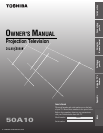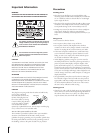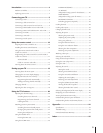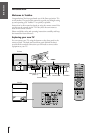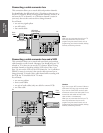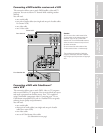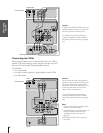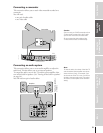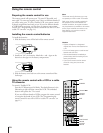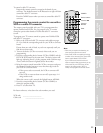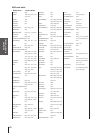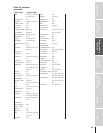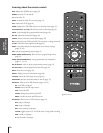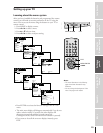
Introduction
Connecting
your TV
Using the
Remote Control
Setting up
your TV
Using the TV’s
Features
Appendix
Index
7
Connecting a DVD/satellite receiver and a VCR
This connection allows you to watch DVD/satellite, video and TV
programs. You can record one TV channel while watching another
channel.
You will need:
• one coaxial cable
• two pairs of audio cables (one single and one pair of audio cables
for a mono VCR)
• one video cable
• one S-video cable
ANT
(
75
)
CHANNEL IN
ON OFF
OUT
RL
OUT
VIDEO
VAR
AUDIO
L/
MONO
IN
DVD IN
L
R
C
R
C
B
Y
L/
MONO
AUDIO
R
S-VIDEO
VIDEO
AUDIO CENTER
VIDEO 1 VIDEO 2
COLOR
STREAM
INPUT
AUDIO
R
AUDIO
IN from ANT
VIDEO AUDIO
OUT to TV
CH 3
LR
CH 4
IN
OUT
IN from ANT
VIDEO
OUTOUT
S-VIDEO
AUDIO
OUT
L
R
Connecting a DVD with ColorStream™
and a VCR
This connection allows you to watch DVD, video, or TV programs
and to record DVD or TV programs. You can record from one source
and watch a program from another source. Your TV is capable of
using ColorStream (component video). Connecting your TV to a
ColorStream compatible DVD, such as a Toshiba DVD, can greatly
enhance picture quality and performance.
You will need:
• one coaxial cable
• three pairs of audio cables (two single and one pair of audio
cables for a mono VCR)
• two video cables
• one set of ColorStream video cables
(See illustration on next page)
Caution:
You can use a video cable instead of the
S-video cable, but the picture quality will
decrease. If you use an S-video cable
between the TV and DVD/satellite receiver,
make the audio connections only and omit
the video connection.
Do not connect the video cable and the
S-video cable to Video-1 simultaneously.
The unauthorized recording of television
programs, videotapes, and other materials
may infringe upon the provisions of copyright
laws.
TV
From Antenna
Stereo VCR
From Satellite dish
DVD/Satellite Receiver



